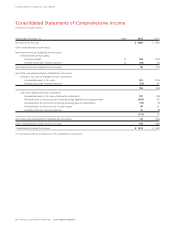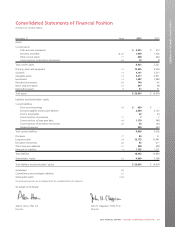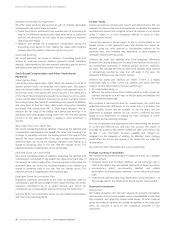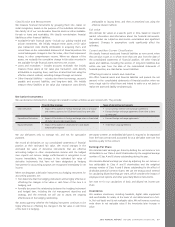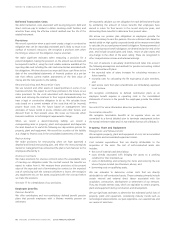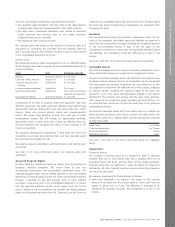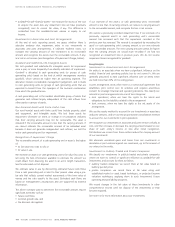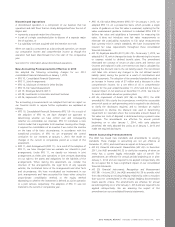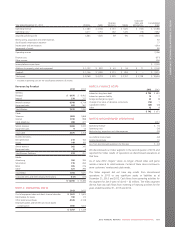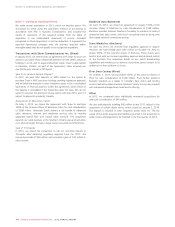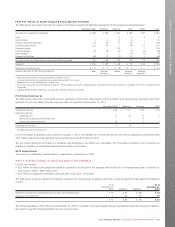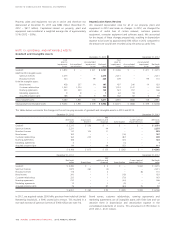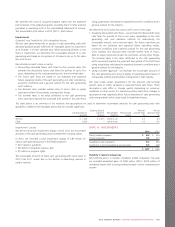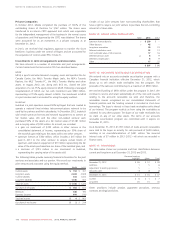Rogers 2013 Annual Report Download - page 104
Download and view the complete annual report
Please find page 104 of the 2013 Rogers annual report below. You can navigate through the pages in the report by either clicking on the pages listed below, or by using the keyword search tool below to find specific information within the annual report.NOTES TO CONSOLIDATED FINANCIAL STATEMENTS
•available-for-sale financial assets – we measure the excess of the cost
to acquire the asset (less any impairment loss we have previously
recognized), over its current fair value, if any. The difference is
reclassified from the available-for-sale reserve in equity to net
income.
Investments in Associates and Joint Arrangements
At the end of each reporting period, we assess whether there is
objective evidence that impairment exists in our investments in
associates and joint arrangements. If objective evidence exists, we
compare the carrying amount of the investment to its recoverable
amount and recognize the excess over the recoverable amount, if any,
as a loss in net income (see Recognition of Impairment Charge, below).
Goodwill and Indefinite-Life Intangible Assets
We test goodwill and indefinite-life intangible assets for impairment
once a year, or more frequently if we identify indicators of impairment.
Goodwill is allocated to cash generating units (or groups of cash
generating units) based on the level at which management monitors
goodwill, which cannot be higher than an operating segment. The
allocation involves considerable management judgement, and is made
to cash generating units (or groups of cash generating units) that are
expected to benefit from the synergies of the business combination
from which the goodwill arose.
A cash generating unit is the smallest identifiable group of assets that
generates cash inflows largely independent of the cash inflows from
other assets or groups of assets.
Non-Financial Assets with Finite Useful Lives
Our non-financial assets with finite useful lives include property, plant
and equipment, and intangible assets. We test these assets for
impairment whenever an event or change in circumstances indicates
that their carrying amounts may not be recoverable. The asset is
impaired if the recoverable amount is less than the carrying amount. If
we cannot estimate the recoverable amount of an individual asset
because it does not generate independent cash inflows, we test the
entire cash generating unit for impairment.
Recognition of Impairment Charge
The recoverable amount of a cash generating unit or asset is the higher
of:
• its fair value less costs to sell, or
• its value in use.
We estimate an asset’s (or cash generating unit’s) fair value less costs to
sell using the best information available to estimate the amount we
could obtain from disposing the asset in an arm’s length transaction,
less the estimated cost of disposal.
We estimate value in use by discounting estimated future cash flows
from a cash generating unit or asset to their present value using a pre-
tax rate that reflects current market assessments of the time value of
money and the risks specific to the asset. Estimated cash flows are
based on management’s assumptions and are supported by external
information.
The above concepts used to determine the recoverable amount require
significant estimates such as:
• future cash flows
• terminal growth rate, and
• the discount rate applied.
If our estimate of the asset’s or cash generating unit’s recoverable
amount is less than its carrying amount, we reduce its carrying amount
to the recoverable amount, and recognize the loss in net income.
We reverse a previously recorded impairment loss if our estimate of a
previously impaired asset’s or cash generating unit’s recoverable
amount has increased such that the impairment recorded in the
previous year has reversed. The reversal is recognized by increasing the
asset’s or cash generating unit’s carrying amount to our new estimate
of its recoverable amount. The new carrying amount cannot be higher
than the carrying amount we would have recorded if we had not
recognized an impairment loss in previous years. We do not reverse
impairment losses recognized for goodwill.
Investments
Investments in Associates and Joint Arrangements
An entity is an associate when we have a significant influence on the
entity’s financial and operating policies but do not control it. We are
generally presumed to have significant influence over an entity when
we hold more than 20% of the voting power.
A joint arrangement exists when there is a contractual agreement that
establishes joint control over its activities and requires unanimous
consent for strategic financial and operating decisions. We classify our
interests in joint arrangements into one of two categories:
• Joint operations, when we have the rights to the assets and
obligations for the liabilities related to the arrangement
• Joint ventures, when we have the rights to the net assets of the
arrangement.
We use the equity method to account for our investments in associates
and joint ventures, and we use the proportionate consolidation method
to account for our investments in joint operations.
We recognize our investments in associates and joint ventures initially at
cost, and then increase or decrease the carrying amounts based on our
share of each entity’s income or loss after initial recognition.
Distributions we receive from these entities reduce the carrying amount
of our investments.
We eliminate unrealized gains and losses from our investments in
associates or joint ventures against our investment, up to the amount of
our interest in the entity.
Investments in Publicly Traded and Private Companies
We classify our investments in publicly traded and private companies
where we have no control or significant influence as available-for-sale
investments, and account for them as follows:
• publicly traded companies: we record them at fair value based on
publicly quoted prices
• private companies: we record them at fair value using well
established market or asset based techniques, or projected income
valuation techniques, applying them to each investment’s future
operating and profitability prospects.
We record changes in the fair value of these investments in other
comprehensive income until we dispose of the investments or they
become impaired.
See note 14 for more information about our investments.
100 ROGERS COMMUNICATIONS INC. 2013 ANNUAL REPORT


